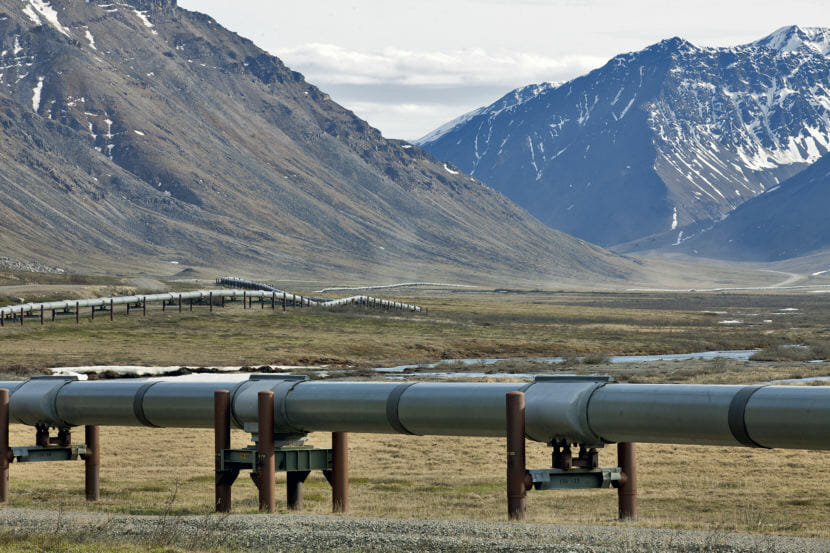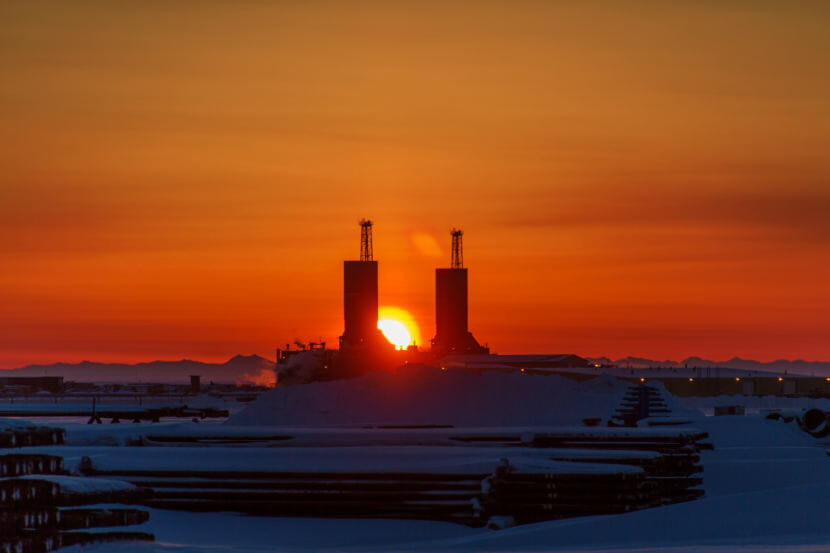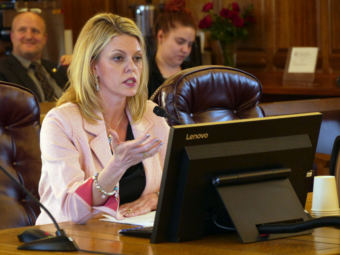
About 500,000 barrels of oil continued to flow daily down the trans-Alaska pipeline this month as the coronavirus pandemic grew at dizzying speeds.
But, while work is continuing on Alaska’s remote North Slope, oil and gas companies say it’s not business as usual. They’re taking new precautions to keep the virus away.
And that includes health checks.
Workers driving the Dalton Highway to the North Slope oil fields must now have a colored wristband or a wallet-sized health card before they can travel to the oil sites beyond Deadhorse — the hub at the end of the haul road at the top of Alaska.
To get a wristband or a card, they first need a check-up, said ConocoPhillips spokesperson Natalie Lowman.
“Our medical screening process is a no-touch thermometer, so one temperature is collected per passenger,” she said. “The worker must pass all medical questions and temperature readings and those who are cleared will be given a wristband, and those are good for one day.”

As the number of coronavirus cases in Alaska continues to increase, the checks are among several measures Conoco says it’s taking to protect its workers who temporarily live on the Slope. Other oil and gas companies in Alaska say they’re also boosting sanitation, keeping workers farther apart and reducing flights.
“We’ve got three very important priorities: protecting the health and well-being of our workforce and their families. We want to mitigate the spread of the virus, and we want to safely run our business,” Lowman said.
Lowman listed the company’s other new measures.
“We’ve limited travel to the North Slope, and we’re deferring some non-critical work to reduce the number of personnel we have on site,” she said.
Out-of-state workers must quarantine for two weeks in Alaska before traveling to the oil fields, Lowman said. To accommodate the change, Conoco recently asked its employees already on the Slope to extend their shifts by another two weeks.
Many Slope employees work two weeks straight, then go home for two weeks before flying back north again.
Lowman said Conoco has about 2,800 employees and contractors working on the Slope. This winter was supposed to be the company’s largest exploration and construction season ever.
Lowman said Conoco’s policies comply with the state’s new two-week quarantine requirement.

Starting Wednesday, Gov. Mike Dunleavy began requiring people traveling into Alaska to self-quarantine for two weeks, unless they support “critical infrastructure,” including oil production. Hundreds of businesses have filed plans with the state outlining how they’ll bring out-of-state workers safely into Alaska. That includes Conoco and BP.
Oil company BP is also asking its workers to quarantine themselves for two weeks before returning to the Slope, but had planned to allow those living Outside to quarantine at their homes there. The company was also looking at flying employees directly from the Lower 48 to Deadhorse, instead of stopping in Anchorage, said company spokeswoman Megan Baldino.
However, the State of Alaska didn’t approve of that plan. Baldino confirmed on Saturday that BP will now have all of its workers self-quarantine in Alaska for two weeks before flying them to the North Slope, including its out-of-state workforce.
BP’s Prudhoe Bay workforce totals about 1,000 employees, and 39% live out of state.
“We continue to review the latest information in this dynamic situation and when necessary are updating our guidance to BP employees and contractors,” Baldino said on Saturday.
Similar to Conoco, BP has also slimmed down its on-site workforce on the Slope to essential personnel, Baldino said. BP has extended many workers’ shifts to at least three weeks. No visitors are allowed at the facilities.
Both BP and Conoco are also screening employees before they board their flights. Their temperatures are taken, and they’re asked about recent travel. Disinfection of buildings and planes has increased. BP is also currently in the process of selling its entire Alaska business to Hilcorp, which declined to comment for this story.
There are also all of the service companies operating on the North Slope, including Cruz Construction.
Cruz Construction’s work includes building ice roads and gravel pads. It also supports drilling crews, said Jeff Miller, the company’s vice president and one of its owners. He said the company has asked its Slope workers to stay weeks beyond their usual shifts, potentially until the middle of April.
“That helped mitigate the risk of bringing or introducing somebody that could have been infected from down here in the Anchorage area or the [Mat-Su] Valley area or Fairbanks, and it kept those camps safe,” Miller said.
Despite the leaner workforce on the Slope, the amount of oil flowing down the trans-Alaska pipeline each day this month has remained similar to last year’s average production.

But while the coronavirus might not be having a huge impact on oil production in Alaska — at least not yet — Kara Moriarty, head of the Alaska Oil and Gas Association, said cratering oil prices likely will.
“I think a lot of people, and rightly so, are focused on the pandemic, but our industry is being hit by two different factors,” she said. “We have the coronavirus, which of course is changing people’s travel with Alaska Airlines cutting back 70% of their flights. Obviously, they’re not going to need as much jet fuel.”
There’s also the oil price war. In early March, Alaska North Slope crude sold for roughly $50 a barrel. By Friday, it was about $26.
“So it’s sort of a double hit for us as the industry adjusts,” Moriarty said.
As a result, Conoco announced it was cutting its capital spending in Alaska by roughly $200 million. That means reducing drilling and demobilizing some drill rigs, Lowman said.
“It’s safe to say that the drop in oil prices isn’t helping any of the situations that we have going on right now,” she said.
Meanwhile, Lowman said, Conoco continues to closely monitor the coronavirus pandemic and will adapt its strategy as necessary. She said the company also has a detailed plan in case an oil field worker gets sick with the virus. It includes identifying who that person had come in contact with, quarantines, medical monitoring and a possible emergency flight off the Slope.
